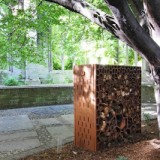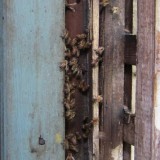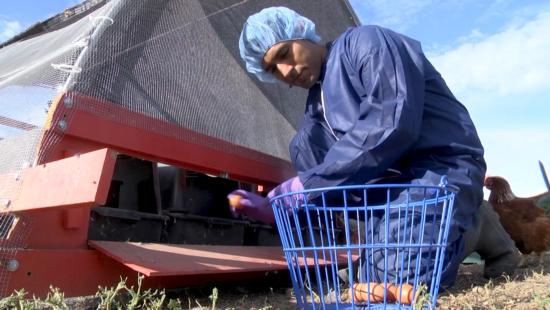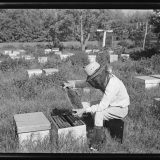
What’s the cause of colony collapse disorder (CCD)? We may be getting closer with the release of a study from the University of Maryland about fungicides and other chemicals used in agriculture.
This study is more interesting than many others I’ve seen. It looked at how pesticides interfere with honeybee’s resistance to a common parasite Nosema ceranae. Bees exposed to a widely used agricultural fungicide, chlorothonatil, were more likely to succumb to nosema. The most provocative result for me was that bees exposed to fluvalinate, a miticide used by beekeepers on their own bees, were also likely to get nosema.
Perhaps the villain in CCD is the beekepers themselves. Don’t get me wrong, pesticides probably play a role in CCD. But we must also remember that commercial beekeepers:
- Treat their bees with pesticides to control mites and these chemicals, as the study points out, harm the bee’s immune systems.
- Move hives thousands of miles every year to provide pollination services.
- Place their hives in monocropped areas where their bees can forage on only one kind of nectar/pollen such as almonds in California and citrus in Florida.
- Use foundation (sometimes made of plastic sometimes made of wax that may be contaminated with pesticides) that does not allow the bees to build their own comb.
- Regulate (through the use of foundation) the amount of drones the queen can make. Drones may be a sacrificial first defense against mites.
- Use queen excluders to prevent the queen from moving freely through the hive.
- Kill the queen and re-queen every year, often using artificially inseminated queens.
- Import hives from other climates.
- Feed hives high fructose corn syrup.
Nassim Nicholas Taleb’s new book Antifragile: Things That Gain from Disorder warns about what happens when we prop up and interfere with complex systems like beehives or the economy. When we don’t allow failure (such as trying to prevent mites with chemicals) we set ourselves up for bigger disasters down the road. It’s very convenient to be able to point the finger at the pesticides farmers use. But just like Ben Bernanke, the big beekeepers can’t see the foolishness of their own practices. Point this out at most local beekeeping association meetings and you’ll be shown the door.
This cluelessness is why I recommend new beekeepers avoid most state beekeeping organizations. For a practical and wholistic approach to beekeeping see Michael Bush’s website, The Practical Beekeeper and look at the videos at the Backwards Beekeepers.
Are you part of a natural, no-treatment beekeeping group? Or is your local beekeeping club open to alternative methods? If so, leave a comment . . .




Great post Erik. I have four hives this year, 2 of which are doing great. Treatment free beekeeping does not mean hands off beekeeping. I usually get in there every other week to do inspections. I just accept the fact that varrao are now a part of a hive population and look for signs of weakness. Three of my queens seem to be haevy brood layers. I have had three swarms this year, none of which I could catch, and requeened my fourth hive with a queen cell from one of the sister colonies. It has been a very educational year for me, and three of the hives are kicking ass. No honey for me though, it is all going to the bees to help get them through the winter!!
Andy – how do you requeen a hive with a queen cell from another hive? I’ve read about putting a frame of young brood in a queenless hive to make a new queen from nurse bee royal jelly, but not the transfer of an actual queen cell.
Max–both will work. If it were me I’d do the brood comb method since I’m lazy. But I’m also interested in hearing from Andy about his queen cell technique.
You point out another important technique–not getting greedy with the honey. We have to place the bee’s health and well-being before we consider honey production.
Hey Erik and Max – Because I had so much swarming this season, there were a lot of queen cells in excess. So what I did was very gently and carefully remove a capped queen cell with a sharp knife and hive tool, and placed it in between two frames of one of my really weak hives that I think was queenless. I gave it two weeks, checked back on them and bam, lots of capped and uncapped brood and eggs. I will check back next week, but I suspect I will see even more bees now. The new queens laying pattern is really nice, so hopefully they have enough time to get established before the snow flies…
Hey Andy,
If you put in a queen cell, it is very, very unlikely that she laid eggs and you got capped brood in two weeks. It should be several weeks before she is laying, and another week before they are capped. Michael Bush has an interesting page on Bee Math at http://www.bushfarms.com/beesmath.htm
Hey Rueben – That is a great page from Michael Bush. I really like what he contibutes to beekeeping and wish I would have had that chart of dates earlier this year. As far as what I described above, my numbers very well could be off. All I know is that the hive that I requeened is doing very well, with lots of capped brood. I am not very good about keeping records, and this is an area that I want to improve in. This is the perfect example of with record keeping is important for us beeks!!
Hey Andy,
Yes, Michael Bush is definitely my guru. I actually just got back from a local bee club meeting, and I don’t think I will bother going again. They basically just spend all their time talking about when and how to put which chemical insecticides into your box full of insects.
Read Bush’s stuff on swarming and queens, too. I found it quite mind-blowing. He says by the time we see swarm cells there is a pretty good chance the bees have already swarmed. Conventional beeks scrape off queen cells–but bees like to have queen cups just in case, so now they have to spend energy rebuilding…
He has a book, but it is basically just his website in paper form. Lots of good stuff on there. He scans old books on beekeeping too.
Very, very interesting.
I stopped using most treatments years ago, although I still use formic acid once in the fall only. No hard chemicals, no antibiotics, etc. State bee inspector came in May and found no disease and no mites, so the hives seem to be O.K.
I have moved frames with a queen cell into a hive that appeared to have no queen (no brood, no apparent queen cells). I brush off all the bees and put the frame into the needy hive. I also make a lot of splits in the spring when there is a lot of pre-swarm activity going on so that by fall I can join colonies that are weak.
Sorry about the break; I was called away by a pack of hungry cats.
One thing that I do with my hives, which the bee inspector thinks might be contributing to the lack of mites, stems from my poor fire-lighting abilities: I just cannot keep the smoker lit for very long. Instead, I use a honey/water spray (always honey from my own hives; never honey from elsewhere) to keep the bees calm while I’m inspecting the hives and I make a concerted effort to spray each frame, both sides, as I’m inspecting. Bee inspector imagines that this may be causing the bees to clean themselves and knock any mites off. I also have screened bottom boards, so once they’re off the bees, they’re out. With my system, I light the smoker once after all the hives are checked and reassemble them one after another before the stupid smoker goes out.
Hope this helps someone else!
Very familiar with the pack of hungry cat problem. Thanks for the tip.
Our local beekeeping group is a diverse mix of new (as are we) and experienced beekeepers. In our group even those who have been using industrial practices for years are at wost polite to the ‘natural’ idealists and more often encouraging if, to varying degrees, skeptical. Just because many of them continue to do what they know does not mean they like it. A few with many beeyards have even undertaken to experiment on a small scale with one.
It is too easy for us to get righteous and sneer at the medicating hive haulers and their ilk but they are trapped by their dependence on the income from their bees. In the first year of transitioning from treating to treatment-free losses of 75% have been reported. For a hobbyist, who expects to be spending money on beekeeping, that is tragic but for the one relying on beekeeping to feed the family and keep a roof overhead it is traumatic.
The individual choice seems to be between “I want bees at large to survive” or “I want these particular bees of mine to survive”. We ought to choose the first but some can not afford to.
Hey, who put this soapbox under my feet?
It’s definitely a difficult decision for a commercial beekeeper. It’s a bit like the handling of the 2008 financial crisis. To not intervene would have meant a depression. To intervene means, perhaps, a worse crisis down the road. Kind of an impossible dilemma for someone in a leadership role.
We don’t keep bees, as in to harvest honey, or anything. But we do have a respectable fruit & veg garden in our front yard to which I’ve worked at adding flowers for the pollinators. I’ve noticed this year we seem to have more honeybees than the past few years. I’m also noticing a nice bunch of bee species. I’m totally not up on identifying bees while in flight, but I’m seeing a variety of sizes and shapes of bugs that are definitely not flies or wasps. I’d like to think we’re doing our own little part to help out the neighborhood bee population!
Very cool–the native bees that you are seeing are also in danger due to the overuse of pesticides.
Just a note, Erik, that many of the experienced natural beekeepers would not say wax foundation *may* be contaminated with insecticides, they would say Every scrap of beeswax IS contaminated with insecticides. The big suppliers collect wax and melt it all together, so the chemicals are spread around.
I wonder if using the word pesticide instead of insecticide exacerbates the problem. Bees aren’t pests, so clearly the chemicals won’t hurt them–these drugs only kill pests! As opposed to Bees are insects, and this chemical kills insects…
Anyhow, plus one on Michael Bush’s website. I found it right after I took a mainstream beekeeping course (the course caused me more troubles than it helped).
My bees are treatment free, and so far are very strong. I collected a swarm last spring, and split them, and then split them again. I regressed them to small-cell size on plastic Mann Lake frames, which I will remove when I am convinced the bees have all regressed to their historic small size (more on Bush’s site).
My local bee club is very active, and very chemical. The president and the bee inspector both told me my bees would die without drugs. So, as theprospectofbees says, people may be supportive, but I sure don’t hear it in our club.
Good point on the semantics of “pesticide” and “insecticide.”
And I agree that wax is contaminated. We don’t use any foundation, but you are right that insecticide probably builds up in the bee’s wax. At least, when I take some honey it does get rid of some of the wax and they have to make new comb.
Ruben,
I was told my hens would get sick and die without a vaccination and antibiotics in their feed. They did not. People who know, don’t really know.
Great post. My family runs a small aviary called Riedman Happy Hives in our back lot (we have 22 hives) in Upstate NY. We don’t use any pesticides and care for the bees using organic solutions. As our name implies – we try our best to keep the bees happy and for that we (and our cutomers) are rewarded with lovely sweet honey! Thanks for this post – very interesting. I’m going to share this on our FB page!
Thanks for the share!
“Drones may be a sacrificial first defense against mites.” Great. Another use for males. I feel really valued now!
Not to mention the whole death after insemination problem. In return, of course, drones don’t do any work and just sit around and get fed. The latter does kind of sound like human males . . .
There seems to be a definite divide between those that are keeping bees ‘organically’ vs. those who are keeping commercial hives, and I think the difference boils down to shear numbers. When you have 150+ hives as a commercial beekeeper, it’s very difficult to do the natural treatments and remedies that many of us can do with a smaller number of hives. Not excusing it, just acknowledging the limitations.
I would agree with your statement that beekeepers are some of the biggest threats to bees today, but I also think they are part of their salvation.
Issues such as Varroa, Hive Beetles, foulbrood, etc.. are transportable when you transport hives to and from areas where different issues affect beekeepers. For example – the Willamette Valley (where our hives are located) didn’t traditionally have much trouble with hive beetles, however – in recent years, that has changed and the number of beetles are on the rise. Where could that come from if the hive beetles aren’t native to the area? Piggybacking in on equipment, mail order nucs, pollination trips, etc.. we’re shipping these diseases and parasites throughout the country in the mail, on equipment, and in hives that are returning from pollination.
Keeping a few hives in your backyard or other locations, with the time and energy and enthusiasm to be consistently working those bees seems to me to be the answer to this quandary, though problematically, it doesn’t take care of the supply of honey for consumers – which comes from what is realistically a monoculture of the apis mellifera variety.
Just like many other issues, notably salmonid conservation – colony collapse disorder seems to be another situation of the ‘death of a thousand cuts’, no single smoking gun, but a confluence of many issues – as I think this latest research seems to indicate.
My local group of friends that keep bees are a natural treatment group, we utilize essential oils, powdered sugar, and other natural-ish treatments to keep our bees – we’ll see how they do come winter, but for now – they are thriving with no issues with varroa or nosema at all, yet.
Fall and winter however will be the true test.
Michael Bush and Dee Lusby certainly have run bees commercially, and with no treatments. For them, no treatments means no essential oils, no powdered sugar, no sacrificial drone frames.
The way to keep bees totally naturally and commercially is to have strong bees. Their outlook is that bees have been doing this for millions of years. Our interventions have made them weaker, and all our treatments, even natural ones, are just crutches for weak bees addicted to treatments.
Let the weak bees die and breed strong bees. I cannot recommend Bush’s website enough.
I can’t but help to notice the similarity of Reuben’s last statement about bee’s and the state of our society. Our interventions make many in our society weaker and more dependent on that assistance. Hmmm, sometimes a little assistance is needed, and other times we need to let nature take it’s course….
Agreed. Taleb talks about this in his book too–of course we need to help the needy. With the bees we can be a little more ruthless in this interest of their long term health. I need to be careful making analogies between bees and humans–they are very different.
They sure are different, Mr. Homegrown.
I guess we try to explain everything mysterious with familiar patterns, so it makes sense we try to anthropomorphize bees. But then fall comes, and they throw all the drones out the front door to die. Or they think their queen is weak, so they kill her.
This is one of the things I love most about keeping bees. I am constantly trying to get inside the “mind” of the hive. I am trying to understand a non-human.
And, I guess, I am in a relationship with a non-human, which is a pretty rare thing. They are harder to understand than dogs or cats, they are totally different.
The Sonoma County Beekeepers are all about practices that build genetically stronger bees over time, and avoiding treatments that will help weaker hives limp along. The local guru around here is Serge Labesque. The beekeepers group is pretty diverse, with a lot of old farmer types, but it is pretty cool to see a consensus around best practices involving the most natural strategies. It has been a great place for me to learn!
Pingback: ruff linkage 201332